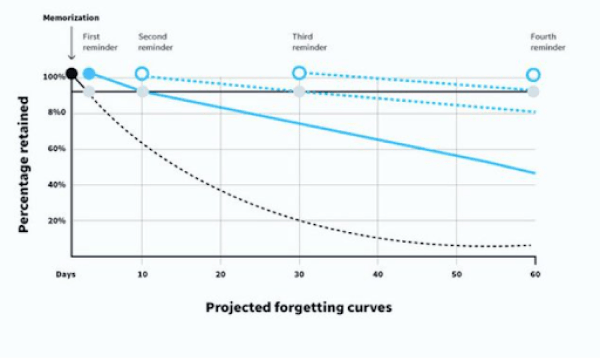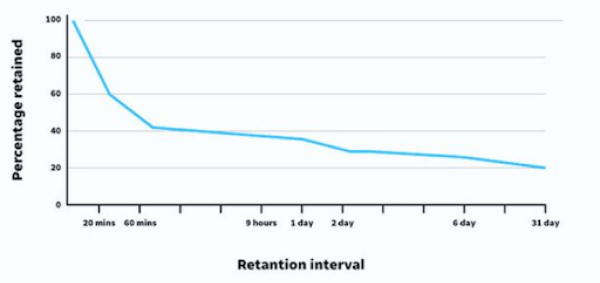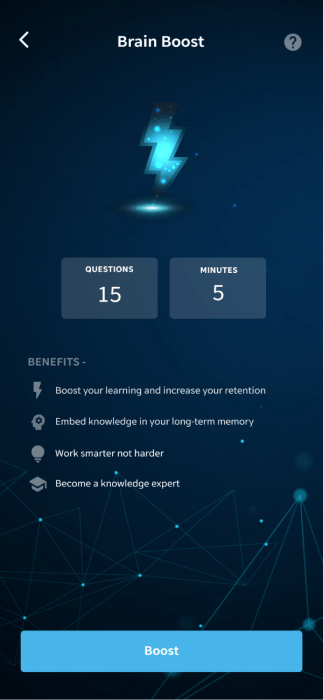Spaced Repetition: How to Make Your Training Unforgettable

Memory is crucial in learning. To ensure that learning materials aren’t easily forgotten after training, you should adopt evidence-based learning techniques like spaced repetition. Read on to understand what it is and how you can apply it in your employee training programs.
If you only want a quick overview, check out this infographic below. But if you have time for a more comprehensive understanding, then you can continue reading the whole article.

What is spaced repetition and how does it work?
Spaced repetition is a learning strategy where lessons are repeatedly reviewed at increasing intervals to ensure that important lessons are unforgettable. Not only does this help reinforce learning, but it also allows you to fill in learning gaps among learners in every recap session until the material is well-remembered and fully understood.
The best way to explain spaced repetition is to think of training the human brain as you would any other muscle – like the biceps. If you want to have stronger arms, you don’t go lift a 100-pound dumbbell on your first gym visit. You’d start by lifting five-pound weights and give your body some time to adjust before moving to seven pounds and then ten pounds. By working your way up to heavier weights in each session, you’ll get stronger arms each time.
Spaced repetition works in a similar way – by reviewing the same lessons at increasing intervals, you are training your brain to keep a piece of information stored longer in your long-term memory, the same way you train your muscles to get stronger.
With spaced repetition, lessons don’t have to be presented in exactly the same way in each review session. There can be variations in teaching the same concepts as long as there are time gaps between sessions. This practice allows you to produce a “spacing effect” among your learners, a phenomenon in which the brain learns more effectively when you space out the teaching of the same concepts.
Understanding the spacing effect
Applying the spaced repetition technique in learning new content produces a “spacing effect” in our brains. Even the learning progress of animals is improved when training is spaced out. To demonstrate this, let’s take a look at how fruit flies react to a specific odor with regards to the spacing effect:
When fruit flies get shocked by a certain odor, they will learn to avoid it next time.
Scenario 1: When fruit flies get shocked by a certain odor, they will learn to avoid it next time.
Scenario 2: When fruit flies get shocked by a similar odor 10 consecutive times, they will learn to avoid it within 3 days.
Scenario 3: When fruit flies encounter a similar shocking odor but at spaced-out intervals, they will learn to avoid it for a week or more.
When fruit flies encounter a similar shocking odor but at spaced-out intervals, they will learn to avoid it for a week or more.
In this example, the learning event for the fruit flies was having an encounter with a shocking odor, which they would want to avoid. When this event occurs consecutively on the same day, they can recall avoiding the shocking odor, but for a short time only. But when they encounter the same shocking odor at spaced-out times, they’re able to remember to keep avoiding that specific odor for a longer period of time.
Similarly, for humans, we’re also able to learn better with spaced repetition as the intervals actually help us keep remembering a piece of information. Scientifically, spaced learning triggers cellular mechanisms in our brains that aid in the formation and maintenance of long-term memories. When we also repeatedly encounter the same information, our brain perceives it as something more important compared to a lesson studied only once.
The theory behind spaced repetition: The Ebbinghaus Forgetting Curve
So, how did spaced repetition come about? Back in the 1880s, psychologist Hermann Ebbinghaus ran experiments where he spent years memorizing lists of nonsensical syllables. He tested whether he could retain information after varying time periods. He found that over time, it becomes harder to remember information that was shown in an initial learning session. This became known as the Ebbinghaus Forgetting Curve, a mathematical formula that shows the rate at which information is forgotten after it’s learned.
As shown in the graph below, the amount of information we retain is sharp in the first 20 minutes but slowly declines as hours and days go by. This means that with only one-time learning, there’s a higher chance of forgetting a lesson.

Despite the dramatic drop in knowledge retention after the initial learning session, Ebbinghaus’ study showed that this drop can be reduced by reviewing the information at spaced intervals—otherwise known as spaced repetition. This technique serves as a way to “reset” the forgetting curve. As the interval increases between learning sessions, the forgetting curve becomes less significant. In a nutshell, you can boost the memory of your learners by allowing them to revisit a piece of information at spaced intervals.
In a nutshell, you can boost the memory of your learners by allowing them to revisit a piece of information at spaced intervals. This includes giving them refresher training courses like regular safety training programs and product owner training courses.

Is spaced repetition really effective?
If all these graphs and data seem overwhelming to you, you may wonder if this spaced repetition technique is really worth all the trouble. Worry not! Many studies support the benefits of spaced repetition in learning.
In 2015, researchers at York University in Toronto looked into the advantages of applying a spacing effect in a review quiz to boost their participants’ performance on a test. Following a 45-minute lecture, half of the students took an online quiz after one day, while the other half took the quiz eight days later. Five weeks after all of the students took their quizzes, they all completed a final exam.
Results showed that:
- Students who took the quiz eight days after the lecture performed significantly better on the exam compared to those who took it only a day after. This suggests that spaced learning really helps improve long-term memorization.
In 2020, researchers at the University of Leicester developed a custom-built web app that personalized a repetition timetable of study material for each learner. Students had the option to use the app with a spaced repetition timetable, use massed repetition timetable, or not use the app at all.
Results showed that:
- Learners who chose space repetition had the highest adjusted mean exam score of 70% compared to the other groups of students in the study. This proves that learners who apply spaced repetition to their studies have the best test results.
Best spaced repetition time intervals
Spaced repetition involves multiple, short review sessions. This way, your learners can take their time processing new information. This is much more ideal than going over the same learning material repeatedly for long hours, which can bore your learners. And when they become bored, they pay less attention, which can then result in poor memory of the material.
Dr. Piotr Wozniak researched the optimal amount of time for spacing out review sessions and developed the first computer algorithm for spaced repetition, called SuperMemo.
Below are his recommended optimal spaced repetition intervals:
- 1st repetition: 1 day after the initial learning session
- 2nd repetition: 7 days after the initial learning session
- 3rd repetition: 16 days after the initial learning session
- 4th repetition: 35 days after the initial learning session
But, you don’t have to strictly follow this interval. The best spaced repetition time interval still varies from learner to learner. For pieces of information that are easily recalled by your learners, you can repeat them at wider intervals instead. Meanwhile, for lessons that are trickier to remember, you can make the intervals shorter. As memory retention improves, you can increase the intervals between the review sessions.
What is an example of spaced repetition?
In practice, if you deploy a lesson for your employees’ HIPAA training today, you can deploy a refresher lesson or quiz the next day. It doesn’t have to be presented in exactly the same way as the initial lesson. There can be variations or different concepts in the way the key points are outlined. The focus should be on the intervals in which your learners are able to review their lesson.
Following the recommended interval in the previous section, you can schedule another refresher on HIPAA compliance 7 days later, then 16 days later, and so on. The intervals basically keep on increasing as your learners become more familiar with HIPAA compliance guidelines.
This way, your learners will be able to remember the most important HIPAA guidelines as weeks and months go by, despite the natural forgetting that can take place.
Applying spaced repetition in training
Training may involve some persuasion to shift employees’ habits or perspectives so they can perform their tasks in a company-standard way. Because of this, one-time training sessions are often not enough for key lessons to stick in their memories. In the book The Owner’s Manual for the Brain, Pierce J. Howard explains that “work involving higher mental functions, such as analysis and synthesis, needs to be spaced out to allow new neural connections to solidify. New learning drives out old learning when insufficient time intervenes.”
Considering spaced repetition, this means that with certain jobs demanding our brains to work harder, learning needs to be spaced to give it time to be stored in the memory. By the time new information comes, the initial lessons are already stored in your learners’ long-term memory.
Learners will naturally forget up to 50 percent of what they just learned within an hour without revisiting the material. But, daily repetitions of key concepts can 95 percent. This makes spaced repetition especially helpful when you want your teams to remember information like compliance guidelines, work processes, new product features, and many more.
While it’s an ideal learning technique, it can be a bit tedious when done manually. Thankfully, there are many available tools to boost knowledge retention among your learners that make applying a spaced repetition strategy more convenient. For bigger teams and corporations, you can take a look at platforms like EdApp that allow you to request spaced repetition features on enterprise plans. Conveniently, this online learning tool also offers a lot of compliance, onboarding, and refresher training courses like product owner training courses, hospitality training courses, and retail training courses.
Boost your learners’ knowledge retention with EdApp
One of the best spaced repetition tools on the market is EdApp's Brain Boost. Especially designed for larger organizations, this nifty feature is only available for teams that opt for an enterprise plan.
It creates automated and personalized follow-up quizzes that are pulled from your existing courses, lessons, or slides in EdApp in just a few clicks! The more answers they get wrong, the more frequently they are quizzed at spaced intervals. This way, the automated spacing completely relies on each learner’s answers and knowledge.

Avail EdApp's enterprise plan and make your lessons unforgettable with Brain Boost!
Other outside sources:
Join our blog newsletter
Author
Shera Bariuad
Shera is a workplace learning expert with a background in planning performance-driven solutions for various business industries. She’s dedicated to driving better learning and development outcomes by providing training strategies for training managers and curating lists of tools and courses for learners. Outside of work, she spends her time reading, illustrating, and designing.
